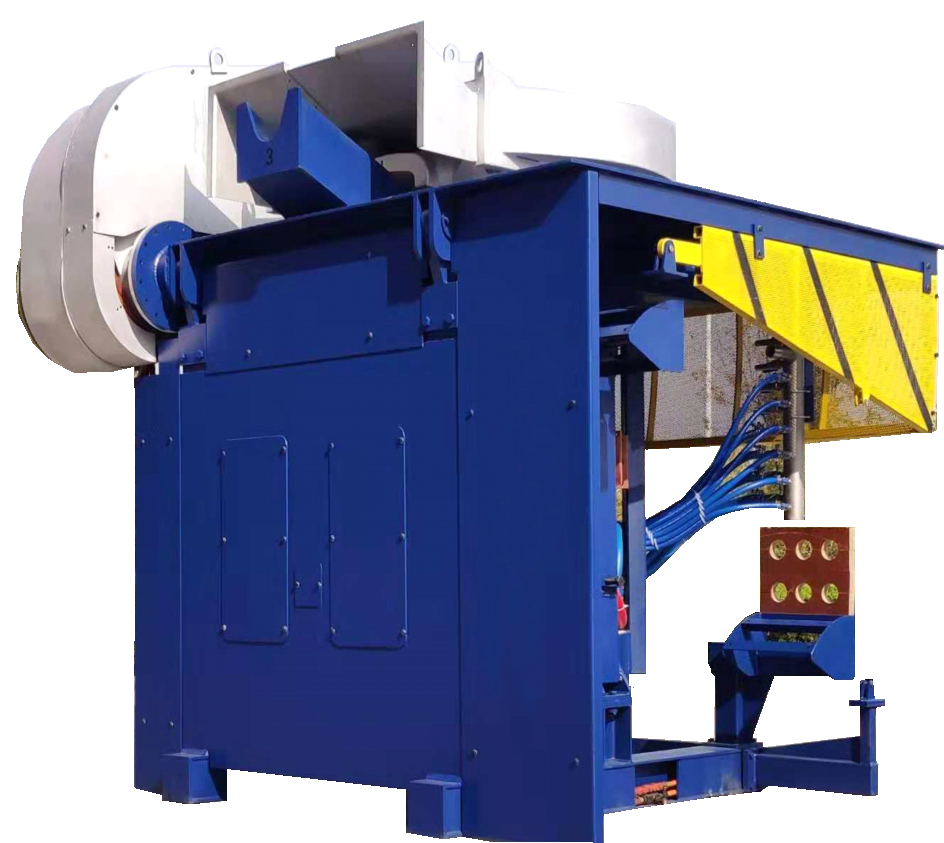
洛阳松导感应加热科技有限公司
联系方式:15038554363
24小时技术热线:15038554363
邮 箱:1390003299@qq.com
厂址:河南省洛阳市洛新工业园区
感应熔化炉熔化率与生产率的关系
需要指出,一般感应熔化炉制造商在样本或技术规格上提供的感应熔化炉熔化能力数据是熔化率。感应熔化炉的熔化率是感应熔化炉本身的特性,它与感应熔化炉的功率大小及电源类型有关,与而生产作业制度无关。而感应熔化炉的生产率则除了与感应熔化炉本身的熔化率性能有关外,还与熔化作业制度有关。通常,熔化作业周期内存在一定的空载辅助时间,如:加料、撇渣、取样化验和等待化验结果(与化验手段有关)、等待浇注等。这些空载辅助时间的存在减少了电源的功率输入,即减低了感应熔化炉的熔化能力。
为叙述清晰起见,我们引入感应熔化炉功率利用系数K1和作业功率利用系数K2的概念。
感应熔化炉功率利用系数K1是指在整个熔化周期内电源输出功率与其额定功率之比,它与电源类型有关。配置可控硅(SCR)全桥并联逆变固体电源的中频感应感应熔化炉的K1数值通常在0.8左右,西安机电研究所对该类型电源增加了逆变控制后(通常的该类型电源仅有整流控制),该数值可接近于0.9左右。配置(IGBT)或(SCR)半桥串联逆变的功率共享固体电源的中频感应熔化炉的K1数值理论上可达到1.0。
作业功率利用系数K2的大小与熔化车间的工艺设计和管理水平、感应熔化炉电源的配置方案等因素有关。其数值等于整个作业周期内电源实际输出功率与额定输出功率之比。通常,功率利用系数K2的大小在0.7 ~ 0.85 之间选择,感应熔化炉的空载辅助作业时间(例如:加料、取样、等待化验、等待浇注等)愈短,K2值愈大。采用表4方案4(双供电源配二炉系统)的K2值理论上可达1.0, 实际上在感应熔化炉空载辅助作业时间很低的情况下可达0.9以上。
由此,感应熔化炉的生产率N可以由下式计算而得:
N = P·K1·K2 / p (t/h)…………………………………………………………………(1)
式中:
P –- 感应熔化炉额定功率 (kW)
K1 –- 感应熔化炉功率利用系数,通常在0.8 ~0.95范围内
K2 –- 作业功率利用系数,0.7 ~0.85
p ––- 感应熔化炉熔化单耗 (kWh/t)
以一台机电研究所生产的配置2500kW可控硅(SCR)全桥并联逆变固体电源的10t中频感应感应熔化炉为例,技术规格表示的熔化单耗p为520 kWh/t,感应熔化炉功率利用系数K1数值可达0.9,作业功率利用系数K2数值取为0.85。由此可得感应熔化炉的生产率为:
N = P·K1·K2 / p = 2500·0.9·0.85 / 520 = 3.68 (t/h)
需要指出,有些用户混淆了熔化率与生产率的含义,将它们视为意义同一,没有考虑感应熔化炉功率利用系数K1和作业功率利用系数K2,这样的计算结果会是N = 2500 / 520 = 4.8 (t/h)。如此选择的感应熔化炉就不可能达到设计生产率。
The relationship between melting rate and productivity of induction melting furnace
It should be pointed out that the melting capacity data of the induction melting furnace provided by the general induction melting furnace manufacturer in the sample or technical specification is the melting rate. The melting rate of the induction melting furnace is the characteristic of the induction melting furnace itself. It is related to the power size and power supply type of the induction melting furnace, and has nothing to do with the production operation system. The productivity of the induction melting furnace is not only related to the melting rate performance of the induction melting furnace itself, but also related to the melting operation system. Usually, there is a certain no-load auxiliary time in the melting operation cycle, such as: feeding, skimming, sampling and testing, waiting for the test results (related to the test means), waiting for pouring, etc. The existence of these no-load auxiliary times reduces the power input of the power supply, that is, reduces the melting capacity of the induction melting furnace.
For clarity of description, we introduce the concepts of induction melting furnace power utilization factor K1 and operating power utilization factor K2.
Induction melting furnace power utilization factor K1 refers to the ratio of the output power of the power supply to its rated power during the entire melting cycle, and it is related to the type of power supply. The K1 value of an intermediate frequency induction melting furnace equipped with a silicon controlled (SCR) full-bridge parallel inverter solid power supply is usually around 0.8. Xi’an Institute of Mechanical and Electrical Technology has added inverter control to this type of power supply (usually this type of power supply only has Rectification control), the value can be close to 0.9 or so. The K1 value of the intermediate frequency induction melting furnace equipped with (IGBT) or (SCR) half-bridge series inverter power sharing solid power supply can theoretically reach 1.0.
The size of the operating power utilization coefficient K2 is related to factors such as the process design and management level of the melting workshop, and the configuration scheme of the induction melting furnace power supply. Its value is equal to the ratio of the actual output power of the power supply to the rated output power during the entire operating cycle. Generally, the power utilization factor K2 is chosen between 0.7 and 0.85. The shorter the no-load auxiliary operation time (for example: feeding, sampling, waiting for testing, waiting for pouring, etc.) of the induction melting furnace, the larger the K2 value. The K2 value of scheme 4 in Table 4 (dual power supply with two furnace system) can theoretically reach 1.0, in fact, it can reach more than 0.9 when the no-load auxiliary operation time of the induction melting furnace is very low.
Therefore, the productivity N of the induction melting furnace can be calculated by the following formula:
N = P·K1·K2 / p (t/h)…………………………………………………………(1)
Where:
P --- Rated power of induction melting furnace (kW)
K1 --- Induction melting furnace power utilization factor, usually in the range of 0.8 ~ 0.95
K2 --- Operating power utilization factor, 0.7 ~ 0.85
p --- Induction melting furnace melting unit consumption (kWh/t)
Take a 10t intermediate frequency induction melting furnace equipped with a 2500kW silicon controlled (SCR) full-bridge parallel inverter solid power supply produced by the Institute of Mechanical and Electrical Engineering as an example. The unit melting consumption p indicated in the technical specifications is 520 kWh/t. The induction melting furnace The value of the power utilization factor K1 can reach 0.9, and the value of the operating power utilization factor K2 is taken as 0.85. Therefore, the productivity of the induction melting furnace can be obtained as:
N = P·K1·K2 / p = 2500·0.9·0.85 / 520 = 3.68 (t/h)
It should be pointed out that some users confuse the meaning of melting rate and productivity, and regard them as the same meaning, without considering the induction melting furnace power utilization factor K1 and operating power utilization factor K2. The result of this calculation will be N = 2500/520 = 4.8 (t/h). The induction melting furnace selected in this way cannot achieve the designed productivity.
手 机:15038554363



















